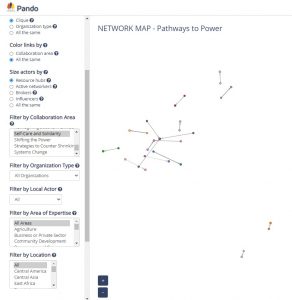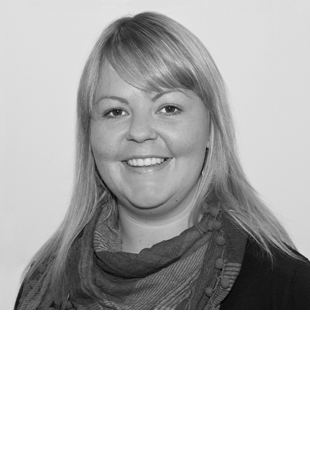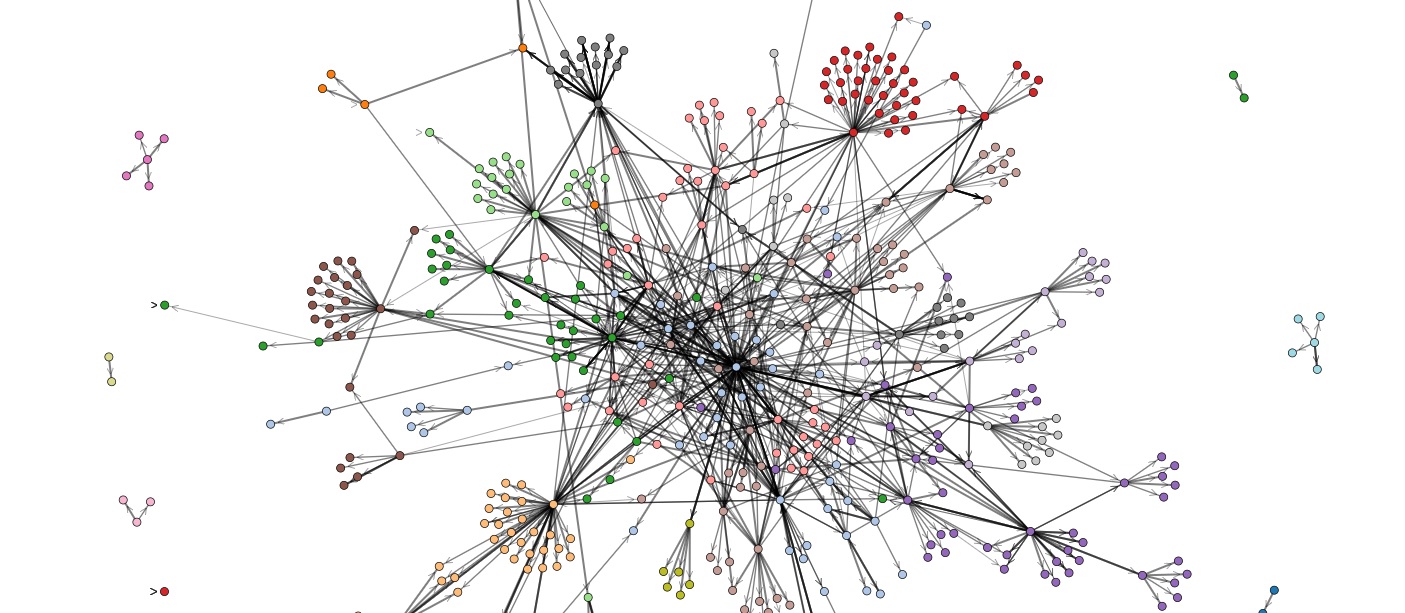Collaboration in the #ShiftThePower movement
08 Jun 2022
This blog is the third instalment in a four-part series exploring the #ShiftThePower network map. Follow along with the conversation, and see here what was discussed in part 1 (Making the invisible visible: #ShiftThePower, mapping and meaning), part 2 (Representation in the #ShiftThePower movement) and part 4 (What’s next for the #ShiftThePower movement?)!
Over the past two years, participants in the #ShiftThePower movement have created a vibrant, living and evolving network map of our community on the Pando platform made up of more than 500 organizations and nearly 1,000 relationships. Originally created to understand representation within the #ShiftThePower community and to strengthen cross-border collaboration, the network map has become a powerful movement building tool to enable us to reflect on our shared goals, challenges and achievements. Throughout this four-part blog series Root Change and the GFCF take a look at what types of organizations make up the #ShiftThePower community, how they’re working together and opportunities to strengthen the movement. In this third post, we’ll consider ways that members of the #ShiftThePower community are working together to achieve common goals.
 Root Change: The #ShiftThePower network map on Pando is built around 12 collaboration areas that were identified by participants in the lead-up to the Pathways to Power Symposium in 2019. Linkages are formed on the map when participants indicate who they go to for information, support, and ideas related to each of the collaboration areas. We can filter by collaboration area to see how participants are working together in each of these areas.
Root Change: The #ShiftThePower network map on Pando is built around 12 collaboration areas that were identified by participants in the lead-up to the Pathways to Power Symposium in 2019. Linkages are formed on the map when participants indicate who they go to for information, support, and ideas related to each of the collaboration areas. We can filter by collaboration area to see how participants are working together in each of these areas.
There are three collaboration areas that we would describe as active and centralized, meaning that there is both a lot of activity and clear resource hubs:
- Community Philanthropy
- Shifting the Power
- Strategies to Counter Shrinking Civic Space
For example, in Shifting the Power, there is a single organization at the centre (the GFCF) and a lot of activity around it.
We also have several of these active, decentralized collaboration areas, where there are no clear resource hubs but there are triads, i.e. connections between at least three organizations. It’s a good sign that there’s cross-collaboration, and ideas and information flow between actors, rather than reliance on certain key actors for information or expertise. These are:
- Funding Practices to Shift Power
- Localization / Local Ownership
- Diversity, Equity and Inclusion
- Systems Change
 Let’s take a look at Funding Practices to Shift Power. In this collaboration area, there are a lot of organizations that have indicated that they work in this area but there isn’t a single actor that has been frequently nominated.
Let’s take a look at Funding Practices to Shift Power. In this collaboration area, there are a lot of organizations that have indicated that they work in this area but there isn’t a single actor that has been frequently nominated.
Does the level of activity in these seven collaboration areas indicate that these are a greater priority for the movement? Or does it simply mean that there is more information or expertise available on these topics?
GFCF: Looking at some of the actors that have a lot of relationships and networks in the map, one would have assumed that those actors would be quite influential across collaboration areas. But it seems like there is very little relationship between the top collaboration areas and the most connected actors. If you click through the collaboration areas, it is clear that key resource hubs are not necessarily present in multiple collaboration areas.
Root Change: This is a theme that has been emerging, namely that people seem to be entering the movement from their vantage point. They are especially active in one collaboration area, but not necessarily all collaboration areas. What are the implications for the movement? What action, if any, should we, as a movement, take?
GFCF: This shows us how siloed we are. We are systemically ill-equipped to see connections between our work and that of others. For example, someone might be doing community philanthropy work in Uganda and say, “I don’t work in shrinking civic spaces”, but of course you do! The civic space has shrunk! There’s a direct correlation between the logic of building community philanthropy in a place that foreign funders can’t fund.
People come at this from their perspective, programming and financial constraints, and mental models. It means that we need to deliberately weave across some of these issues. It might be a good discussion to say, where do these conversations need to join up with each other?
Root Change: Another entry point might be where people are collaborating the most. Who could be potential stewards of certain collaboration areas and help unite this space?
For example, the Localization / Local ownership collaboration area is decentralized and isolated. There are people working off in their own spaces, but there are emerging resource hubs in this space. Would these few key actors be willing to take on a particular role within the movement? If there are collaboration areas where we would like to see more cohesion and collaboration, are there certain actors that could help foster that?
GFCF: One way to proceed might be to bring at least two topics together as a matter of practice, otherwise you end up reinforce existing patterns. At the same time, if one starts weaving across collaboration areas, it would be really important to ensure that they don’t end up undermining one another. There is something important here about cultivating the right kind of culture and tone within this space, that sense of “movement generosity” that is referred to in the #ShiftThePower Manifesto for Change. There are other things happening in this system already and we don’t need to reproduce them. Then you start thinking in terms of systems, rather than areas of expertise.
 Root Change: Let’s look at some of those collaboration areas that are less active. While we see more activity than we did a year ago, these collaboration areas still have fewer relationships, a limited number of resource hubs, and isolated groups of actors. The least active is Self-Care and Solidarity. Others have more collaboration, but still don’t compare to those mentioned earlier:
Root Change: Let’s look at some of those collaboration areas that are less active. While we see more activity than we did a year ago, these collaboration areas still have fewer relationships, a limited number of resource hubs, and isolated groups of actors. The least active is Self-Care and Solidarity. Others have more collaboration, but still don’t compare to those mentioned earlier:
- Positive Narratives
- Reimagining INGOs
- Reimagining Southern Civil Society
- Evidence for Change
Are there any actions that the movement might want to take with that information?
GFCF: In many ways, these collaboration areas are the “glue” between the established pillars. If, for example, you think about self-care as supporting the people working within organizations that work for other people, for equity and justice, it’s essentially about humanizing development so it’s not so technocratic, and putting dignity – rather than projects or log-frames – at its heart.
These are critical pillars; they’re not just by-products of what programmes produce. It’s important to keep nudging these along and foster the realization that these are the glue that holds everything together. There’s the opportunity to help organizations realize that they work in this and can become potential hubs.
Root Change: It’s almost surprising that Self-Care and Solidarity hasn’t grown given COVID-19 and the collective conversation about the need for greater solidarity and mutuality. Less activity doesn’t mean dormant, it just means that there is more work to be done in these spaces. In recent months we have seen that there has been more activity in these collaborations.
GFCF: We added Reimagining Southern Civil Society as a collaboration area as a challenge to not just make this about funders and INGOS. If there is to be a “re-imagining” of the international system, then what are the equivalent conversations that need to be happening in the Global South? This is one for us to keep an eye on. Civil society needs to be owned by and in service of people, not funders, so what does that mean in practice? It’s ultimately the most important collaboration area on the map: what do we want our organizations to look like in the future?
Root Change: This was raised in The Global #ShiftThePower ecosystem webinar (held in July 2021), i.e. ensuring that Southern civil society doesn’t just replicate the norms, structures – and behaviors – of INGOs. Because this isn’t currently an intentional, named focus, it would be interesting to see if the organizations that have been nominated in this collaboration area actually identify as “Reimagining Southern Civil Society.” Or is this something that others perceive them to be doing? Take CIVICUS, for example: is this how they think about their work? It would be interesting to speak with the organizations that have been nominated in this area to learn more about their work and strengthen their collaboration.
GFCF: What are some of the movements that are happening within the broader #ShiftThePower movement, particularly those that might be small but significant? Is that something we can say a little bit about?
Root Change: We do see groups of organizations coming together and collaborating more frequently within the movement. We can see one cluster that is made up of influential African and global organizations, for example, like the Zambian Governance Foundation, Africa Philanthropy Network, Kenya Community Development Foundation, and CIVICUS. There’s another cluster that seems to be forming around community foundations and American funders, just to name a couple. This begins to show us that there is some strong collaboration happening among like-minded organizations that are coming together for various reasons. In some cases, it may be geography, in others it’s because of a shared collaboration area.
Using this information, it would, theoretically, be possible for movement members to be more intentional when it comes to building both bonding social capital (helping organizations and sub-groups to feel strong and united), as well as bridging social capital (ensuring that these groups are interacting and working with others in the broader movement).


